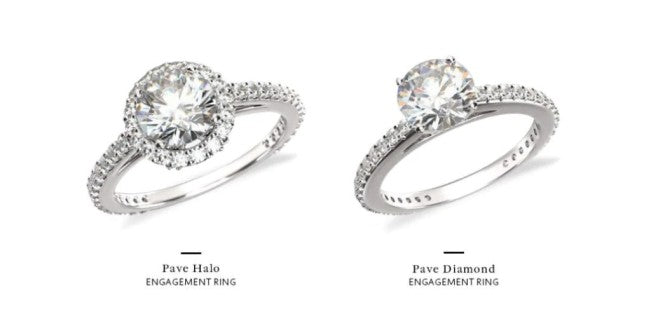Here's What You Need to Know Before Buying a Pave Setting

Shopping for an engagement ring on a budget? You're not alone; in fact, it's more the rule than the exception these days. There are beautiful and stylish ways to maximize your ring budget. First, you're in the right place: Shopping online for an engagement ring can save you 40 to 50 percent off brick-and-mortar jewelry stores. Second, consider a setting that incorporates extra-small stones, like a pavé setting.
TABLE OF CONTENTS
What is a Pavé Setting?
Pavé (pronounced pah-vay), from the French word for "paving," is a setting in which several small diamonds or gemstones accentuate the main stone, creating a field of sparkle. Usually, the diamonds are so closely set that the metal beneath them can't be distinguished from the diamond; to help with this, most buyers pick white gold for their band in order to ensure minimal visibility of the metal prongs that hold the diamonds in place. The pave ring setting may also be referred to as a "bead" setting, and if the paved stones are especially small (smaller than about .01 carats), a micro-pavé setting.

Because of the added shimmer, a pavé ring setting can make a diamond look larger than it actually is, allowing you to save money by choosing a smaller center stone. A pavé setting is different from a ring with side stones, because of the number and density of stones: A pavé setting resembles a street paved with diamonds, while a side stone ring may utilize larger diamonds or gemstones to accentuate the focal stone.
Different Styles of Pavé Settings

Micropave
In this style, accent diamonds are set closely together, secured with small prongs. This draws attention to the diamonds while minimizing the look of the metal. Jewelers must work with high precision to create this setting; lasers are often used to produce a flawless result.

Micropave Set
In this style, accent diamonds are set closely together with small beads of metal holding them together. This draws attention to the diamonds and their sparkle, minimizing the look of the metal. Jewelers must work with high precision to set stones with this technique; lasers are often used to produce a flawless result.

French Pave
This style, similar to micro pavé, incorporates a small, V-shaped cutout underneath each diamond, which allows for more light to hit the stone and less metal to show on the ring.

U-Cut Pave / Scallop
In a U-cut or scalloped setting, the metal beads holding the accent diamonds have U-shaped cutouts underneath, adding a distinctive design element.

Bright Cut / Channel
The most traditional setting, the bright cut (or channel setting) is so named because the diamonds look like they're held by two walls of metal. This setting has seen a resurgence in popularity recently thanks to a growing interest in vintage and vintage-style engagement rings and jewelry.

Shared Prong
In this style, two accent stones are held together by the same prong, minimizing the metal, enabling a tighter and more uniform look, and enabling light to hit the diamonds and maximize sparkle.

Surface Prong
The most common setting, each diamond is held tightly in place by a tiny metal prong. They can be rounded, flat, pointed, or V-shaped.

Bar
The bar setting holds diamond accents in place with bars of metal on either side. This secure setting style is typically used for baguette-style diamonds in three-stone rings or eternity bands.

Bezel
In this setting, diamonds or gemstones are enclosed by metal. This holds the stone securely in place and adds a pretty design element. Bezel-set rings are popular with both men and women and have long-lasting appeal.
Pros of Getting a Pavé Ring Setting
The biggest benefit to a pavé ring setting: You get more sparkle for less money. Pavé set rings have one continuous shine, giving the wearer the illusion that the diamonds are more plentiful and bigger than they actually are. This setting also allows for the center stone to be highlighted and exemplified through the sparkle of the side stones. Pavé in a halo setting — in which small diamonds encircle a larger stone — can make a center stone look bigger and add shine if the center stone is low set. The pave setting is also extremely flexible and works beautifully within modern or vintage-style engagement rings.

Things to Consider About the Pavé Setting
As with any style of ring, there are also some caveats to the pavé setting. It is recommended for diamonds only, as it doesn't offer protection for more fragile gemstones. Additionally, the close pave setting makes resizing the ring difficult. There's also a low but still present chance of losing the side stones. When caring for the ring, it is important to remember that soaking a paved set engagement ring increases the likelihood of diamonds coming loose — be sure to take extra care in cleaning and maintaining a pavé engagement ring.
How to Clean a Pave Diamond Ring
As with all other precious jewelry, use a cleaning solution that's designed specifically for the metal and the gemstone that you are wearing. If you do not have a cleaning solution that's made for that jewelry, ensure that you use a soft-bristled toothbrush and warm soapy water. No chemicals or harsh abrasive materials should be used. Use the brush to ensure you clean in and around prongs and crevices on the ring. Have jeweler steam clean and ultrasonic clean the jewelry to ensure it maintains the best finishing. Following these steps will ensure that your pave ring or pave wedding band is safe to wear every day and is sparkling and clean. Always be sure to remove the ring while cooking, cleaning, exercising to ensure that the ring does not get filmy, dirty, or greasy.







